Although the art form of bonsai has been around for hundreds of years and is being practiced globally, not many people fully understand its concept yet.
More than just “potted trees,” it’s an artistic expression to many, especially to the first bonsai artists who started it.
Now, for every aspiring artist like you to fully grasp the meaning and art of bonsai…
Read on to discover:
- The origin and history of bonsai.
- 15 different styles of bonsai trees.
- The characteristics of a classic bonsai tree.
- Most common tree species used as bonsai specimens.
- And so much more…
Bonsai Meaning
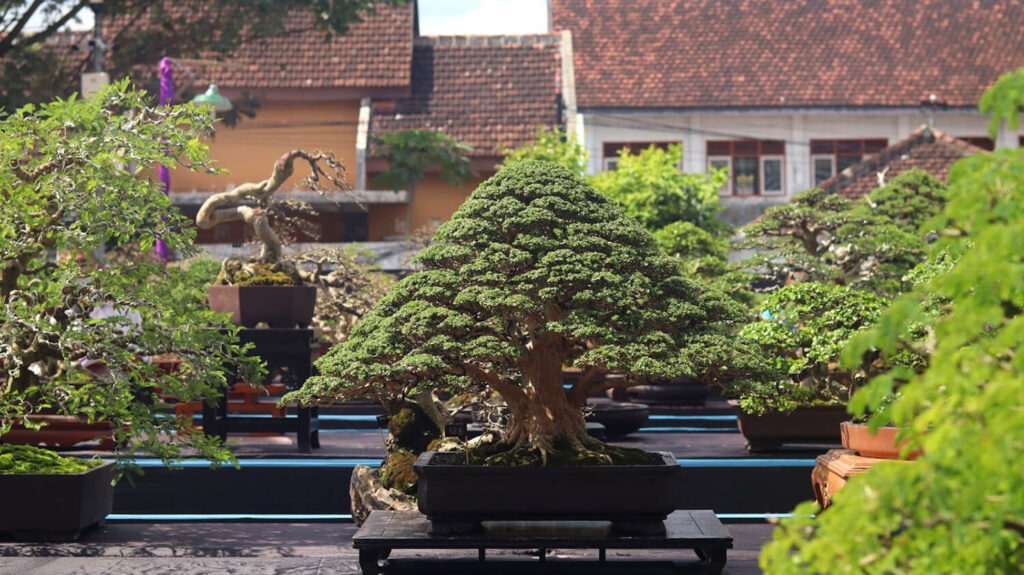
Dwarf trees planted in small pots—that’s how most people probably see bonsai. While that may be true, these aren’t just like any other potted plants.
The term bonsai comes from two Japanese words: “bon,” which signifies a “tray” or “container,” and “sai,” implying “plant” or “tree.” Hence, the Japanese word bonsai essentially means “planted in a tray or container.” It’s derived from “penjing or penzai,” an ancient horticulture practice in China (which you can learn more about below).
Unlike what the general public may think, bonsai plants aren’t genetically dwarf trees. In fact, you can make any tree species into a bonsai by performing various bonsai techniques, such as pruning and wiring.
The very first trees were collected from the wild—called yamadori. Artists dig small, raw materials from the mountains, forests, and other permitted lands.
The ultimate goal of growing a bonsai is to create a realistic representation of nature, specifically trees, in a miniature form.
To do that, you’d need a good sense of aesthetics and enough horticulture knowledge, as controlling the tree’s growth is necessary to successfully create a masterpiece.
Bonsai as an Art
Bonsai trees are living art. Unlike other forms of art, it undergoes several changes in form and style throughout its life—depending on whose artist oversees it.
There are masterpieces from hundreds of years ago that are still circulating within the community, both in and outside Japan. Many of them are created by some popular bonsai masters—handed down from one generation to another.
That explains why many masterpieces are priced expensively and displayed in some prestigious bonsai museums.
Origin and History

As mentioned, it was derived from ancient Chinese horticulture called penjing or penzai, which was practiced in 700 AD. It’s the art of training evergreen trees or shrubs into small containers.
These potted trees during those times were treated as luxurious gifts as only the elites could practice penjing art.
Unlike the bonsai we know today, penjing trees were planted in deeper containers and were sometimes styled with miniature landscapes and figures.
Bonsai in Japan
During the Kamakura period (1192-1333), Japan adopted many cultural art and trademarks from China, including the art form of penjing.
Portrayals of “dwarf trees” can be seen in Japanese scrolls as early as 1309.
It was then redeveloped into bonsai art (which wasn’t called “bonsai” yet until later) due to the influence of Japanese Zen Buddhism. Many, if not most, of the bonsai tools and techniques used today were redeveloped from China origins.
It took 300 years before the art of bonsai became widely popular and enjoyed in Japan. This was during the Edo period (1603-1867) when Japanese art and culture flourished.
Around 1800, the art of cultivating bonsai was formally called “bonsai” when a group of Chinese art scholars visited Osaka and discussed its current form.
It continued to thrive during the Meiji period (1868-1912) when the public started seeing bonsai trees as art objects. During these years, scholarly books were first published, and large-scale exhibitions formally started.
Omiya Bonsai Village
After the Great Kanto Earthquake in 1923, several professional artists, including some well-known masters, searched for fresh land in Saitama to build nurseries.
This place is now what we know as Omiya Bonsai Village, the center of Japanese bonsai. It was established in 1925 and now homes six nurseries where many enthusiasts go to learn and study bonsai art.
Timeline:
- 700 AD — Elites in China practiced Penzai art.
- 1192-1333 (Kamakura period) — Japan adopted many Chinese cultural trademarks, including training potted trees.
- 1603-1867 (Edo period) — The public widely enjoyed bonsai.
- 1868-1912 (Meiji period) — Publication of scholarly bonsai books and large-scale bonsai exhibitions was formally started.
- 1925 — The Omiya Bonsai Village was established.
Bonsai Culture Today
As time passes, the art and style of bonsai continue to change and transform.
Compared to before, many artists today are not afraid to experiment on their trees and showcase abstract or bold styles.
One prime example is master Masahiko Kimura who was once “criticized” for his style that goes against the “standard.” However, not long after, people started to appreciate the uniqueness and boldness of Kimura’s craft.
Bonsai art is also now widely practiced throughout the globe, expanding its market in many Asian and Western countries.
Enthusiasts today exchange works and knowledge through apprenticeships, global exhibitions, and international organizations held within and outside Japan.
While there are countless organizations and exhibitions worldwide, here are the well-known and prestigious ones that greatly contributed to the community today:
Some of the active and most popular bonsai organizations:
- Kofu Bonsai Kai
- California Bonsai Society (CBS)
- Nippon Bonsai Association (NBA)
- National Bonsai Foundation (NBF)
- World Bonsai Friendship Federation (WBFF)
Some of the active and most popular bonsai global exhibitions:
- World Bonsai Convention
- Koju-ten Bonsai Exhibition
- Sakufu-ten Bonsai Exhibition
Read more about bonsai art and cultivation at www.hookedonbonsai.com.
Characteristics of a Classic Bonsai Tree
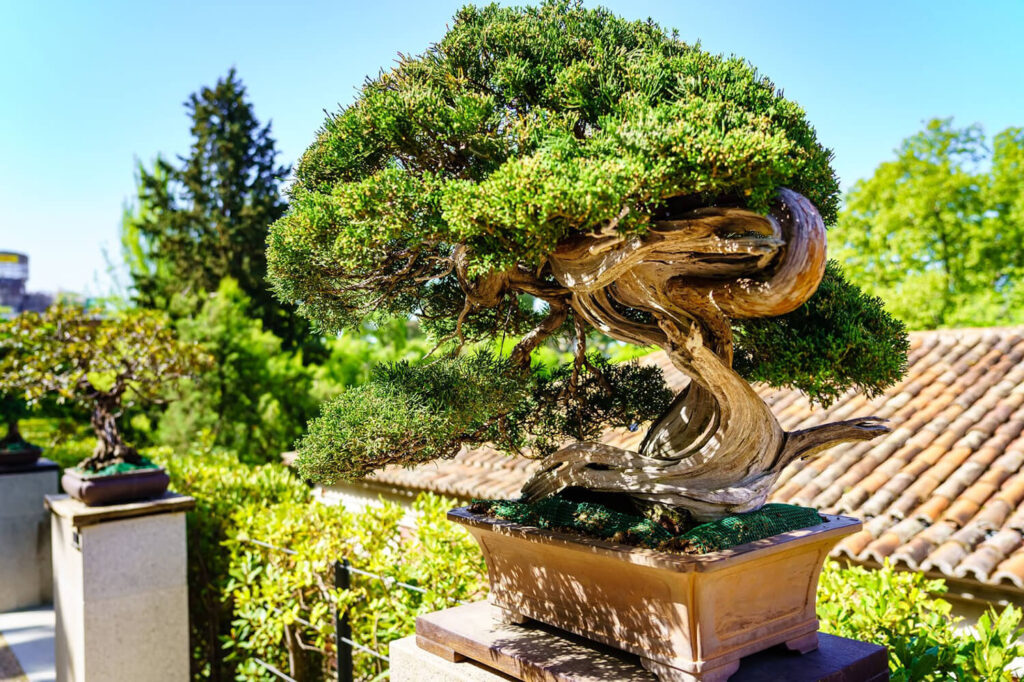
For a specimen to become a potential tree material, it has to have several specific features. It has to have attributes that can help mimic a natural tree realistically.
Here are the important characteristics of a classic bonsai:
- Foliage pads
- Surface roots
- Textured bark
- Branch ramification
- Tiny fruits or flowers
- Thick, woody trunks and stems
- Small, reducible leaves or needles
- Live and deadwood interplay (for some species like shimpaku juniper)
Plus, it must be small enough to fit in a small, shallow pot.
Note: A plant doesn’t need to have all these characteristics to become a potential plant material. What’s important is finding and highlighting its best features.
Size classifications
Any small, woody plant planted in bonsai pots can be called a bonsai.
However, did you know that there are names for different tree sizes? What’s more interesting about it is that these name classifications were originally based on how many men lift the tree.
Check out this table below:
| Bonsai classification | Hand-scale | Size range |
| Keshitsubo | Fingertip | 1-3” (3-8 cm) |
| Shito | One-handed | 2-4” (5-10 cm) |
| Mame | One-handed | 2-6” (5-15 cm) |
| Shohin | One-handed | 5-8” (13-20 cm) |
| Komono | One-handed | 6-10” (15-25 cm) |
| Katade-mochi | Two-handed | 10-18” (25-46 cm) |
| Chumono/Chiu | Two-handed | 16-36” (41-91 cm) |
| Omono/Dai | Four-handed | 30-48” (76-122 cm) |
| Hachi-uye | Six-handed | 40-60” (102-152 cm) |
| Imperial | Eight-handed | 60-80” (152-203 cm) |
Different Bonsai Styles
Aside from sizes, they are also categorized according to their styles or forms—inspired by how different trees naturally grow in various zones.
1. Chokkan (Formal upright)
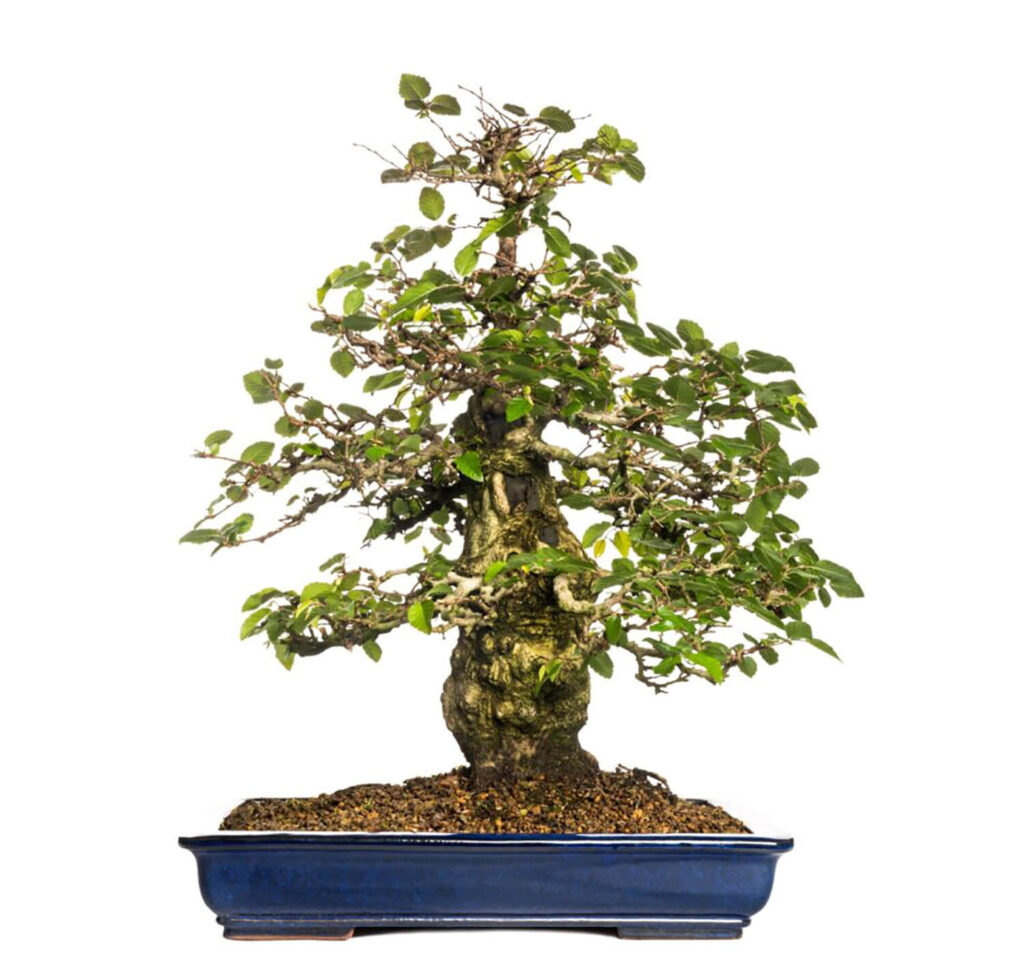
Inspiration: Natural trees that grow in between the rocks’ cracks and holes.
This bonsai form has a straight, upright trunk and well-balanced branches that extend in all directions. Its trunk grows thick at the bottom and becomes thinner as it elongates.
2. Moyogi (Informal upright)
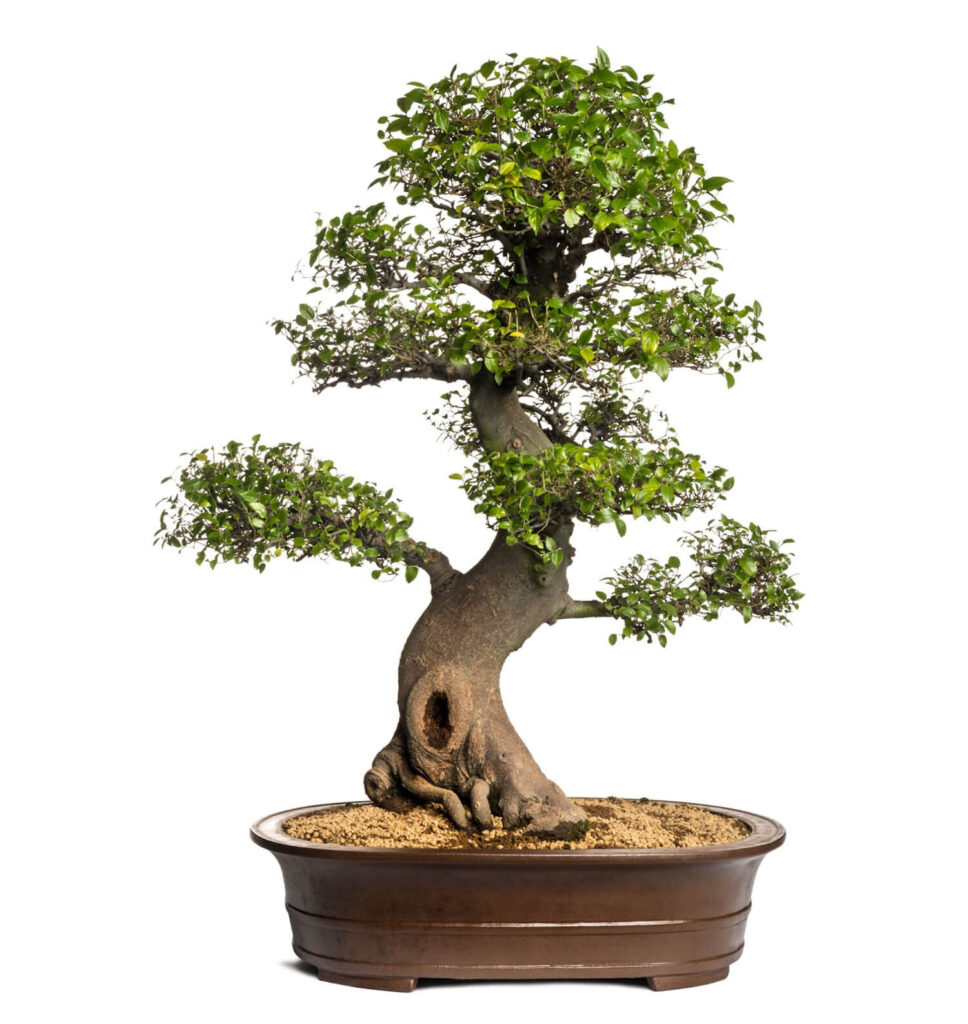
Inspiration: Trees that grow in areas with lots of sunlight.
It’s mostly the same as chokkan except that its trunk has an “S” shape, which gives it an interesting appeal. The branches extend on every branch trunk turning to emphasize the curves.
3. Shakan (Slanting)
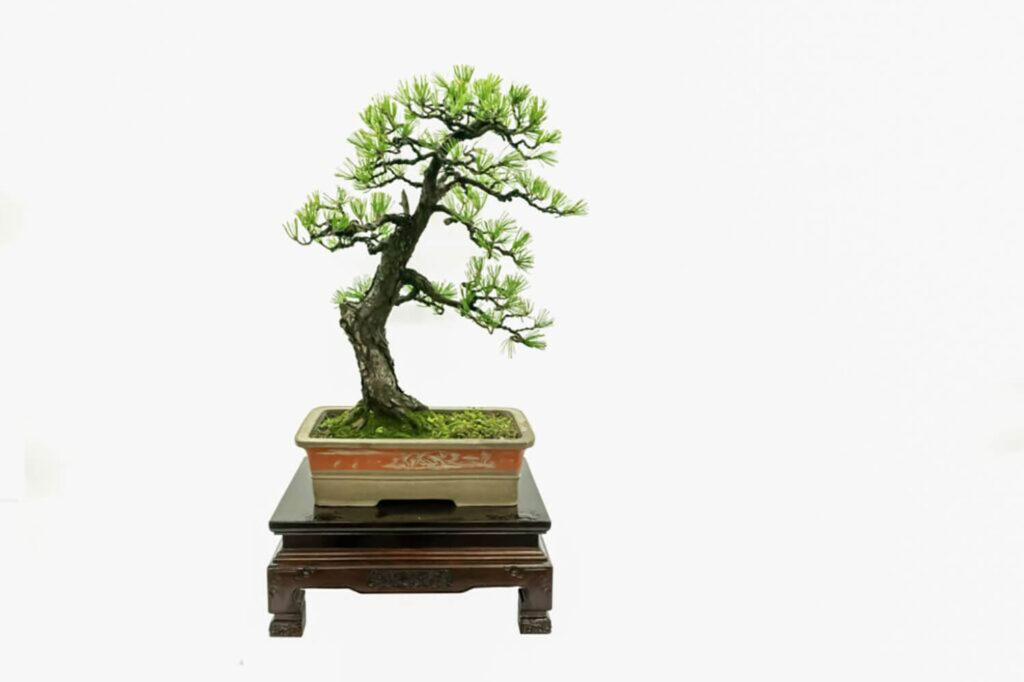
Inspiration: Trees bent on one side due to strong winds blowing in one direction or trees growing in the shadow reaching for sunlight.
Shakan trees grow at about 60 to 80 degrees angle, with their trunk thicker at the bottom. The roots opposite the leaning direction are often more well-developed to support the tree’s weight.
4. Fukinagashi (Windswept)
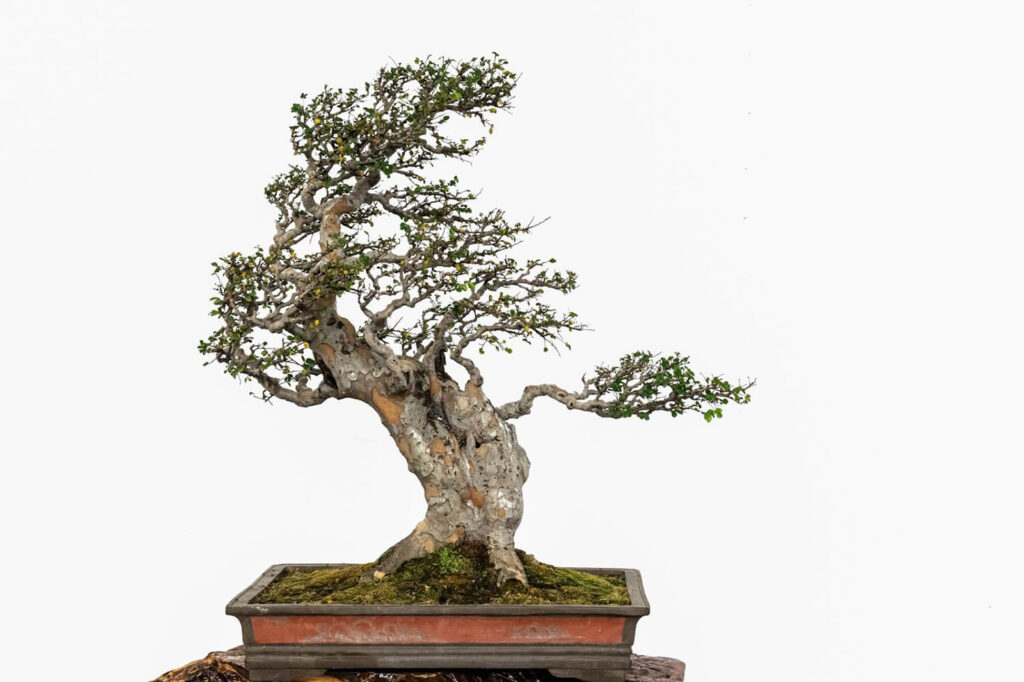
Inspiration: Trees or shrubs shaped by strong winds.
This style has a bent trunk and branches extending in one direction. This form helps make it appear like a strong wind is blowing through the plant.
5. Bunjingi (Literati)
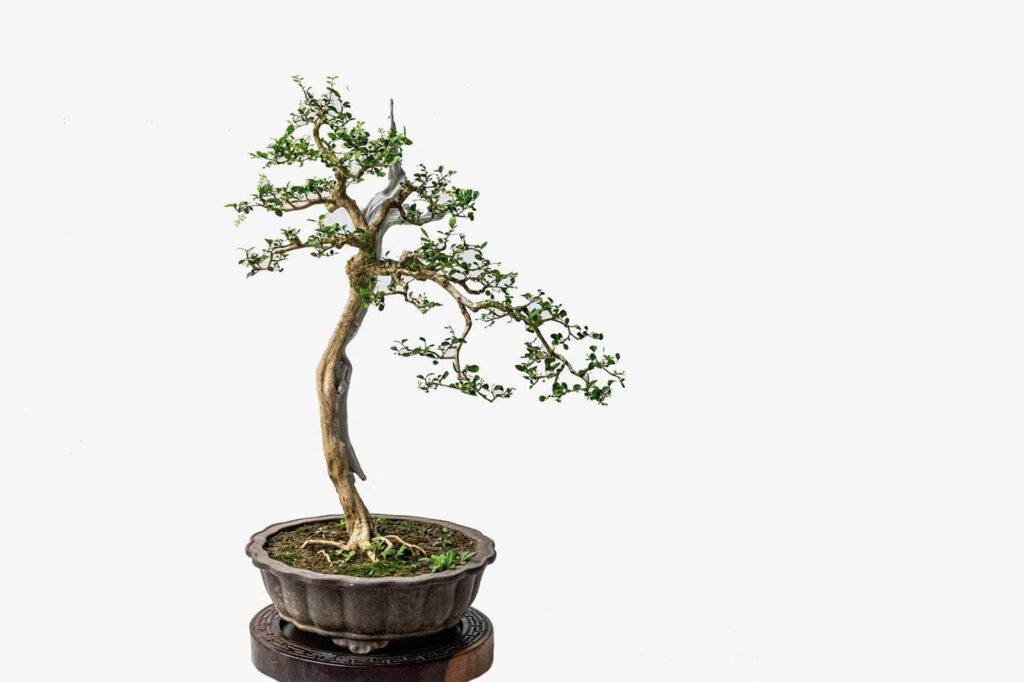
Inspiration: Trees growing in densely populated areas and compete to receive sufficient sunlight at the top.
This type of tree is mostly bald and only has foliage at the top of its trunk. To make it look more like it’s struggling to survive, some artists create jins on cut-off branches.
6. Hokidachi (Broom)
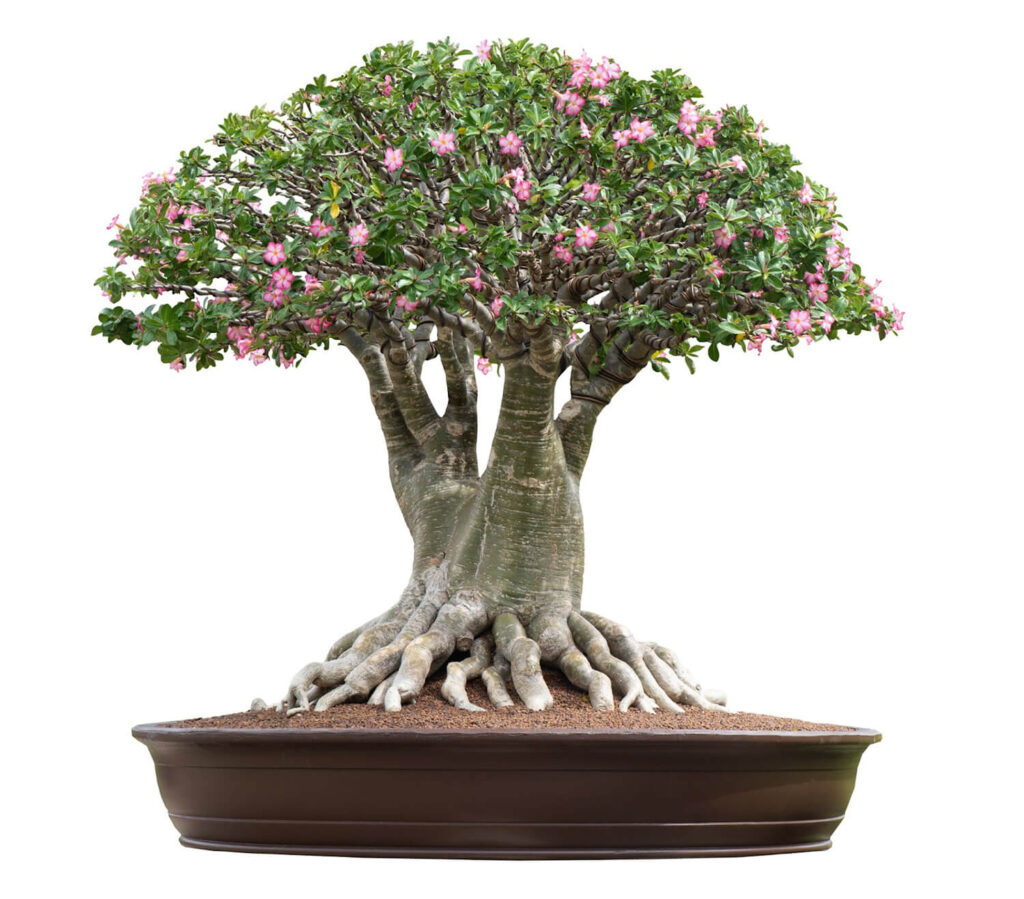
Inspiration: Trees with thick trunks and fine branching.
This one has a straight-upright, thick trunk and fine branching that extends in all directions, forming a broom-like shape. It’s best suited for deciduous trees so that viewers can witness its stunning branch ramification during winter.
7. Han-kengai (Semi-cascade)
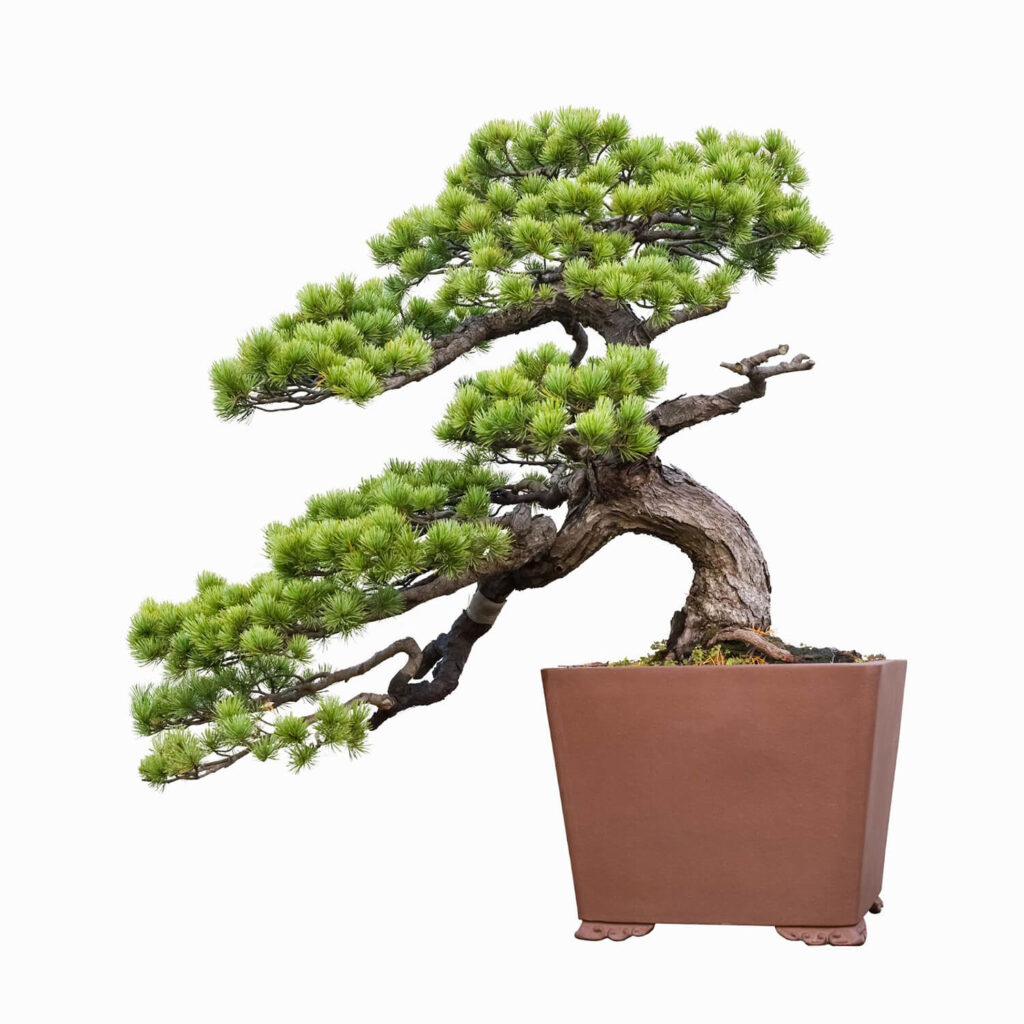
Inspiration: Trees that grow in cliffs, lakes, and riverbanks.
Unlike the styles above, this one has a heavily bent trunk reaching the pot’s rim. It’s planted in a deeper pot to avoid the lower branches from hitting the ground and create a balanced proportion.
8. Kengai (Cascade)
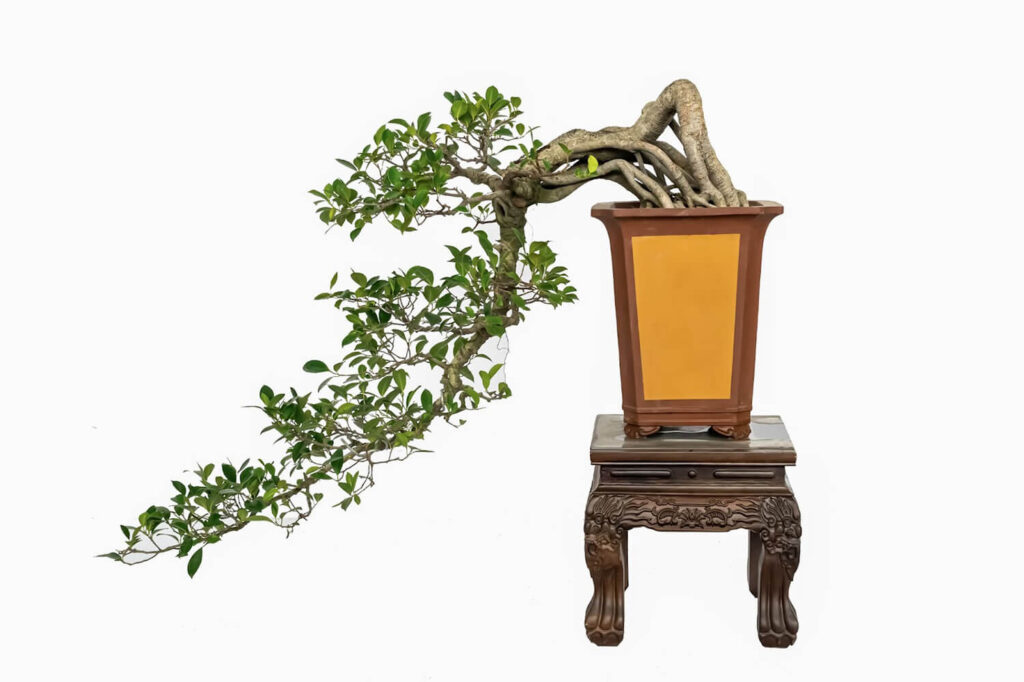
Inspiration: Trees on steep cliffs that bent due to falling snow or rocks.
It’s similar to han-kengai, except that its lower branches reach the bottom of the pot. Artists grow it horizontally in a tall, narrow pot to keep a good balance—making it one of the most difficult trees to maintain.
9. Sharimiki (Shari/Driftwood)
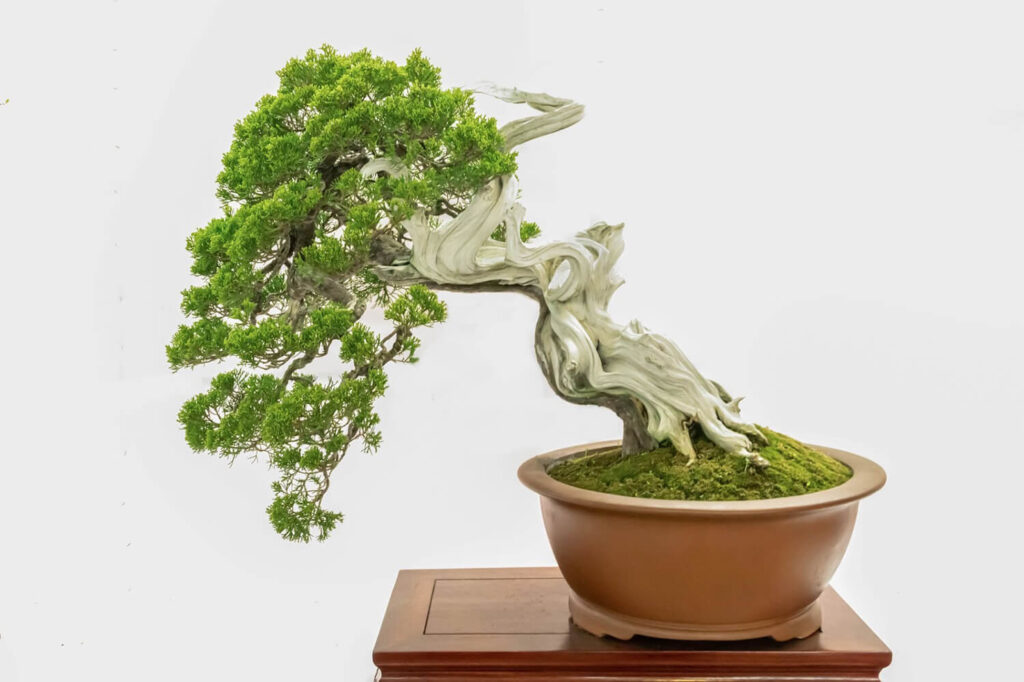
Inspiration: Old trees that grow in zones with harsh weather conditions.
Shari is a long, white strip of deadwood on the trunk, which helps depict old age and survival. Artists create this by removing the bark on the deadwood and applying lime sulfur onto it to speed up the bleaching process.
10. Sokan (Twin-trunk)

Inspiration: Trees in nature that naturally have double trunks.
Its thinner, often slanted “second” trunk could grow out of the same root system or out of the larger trunk above the ground. Despite having two trunks, both contribute to forming a single crown.
11. Kabudachi (Multi-trunk)
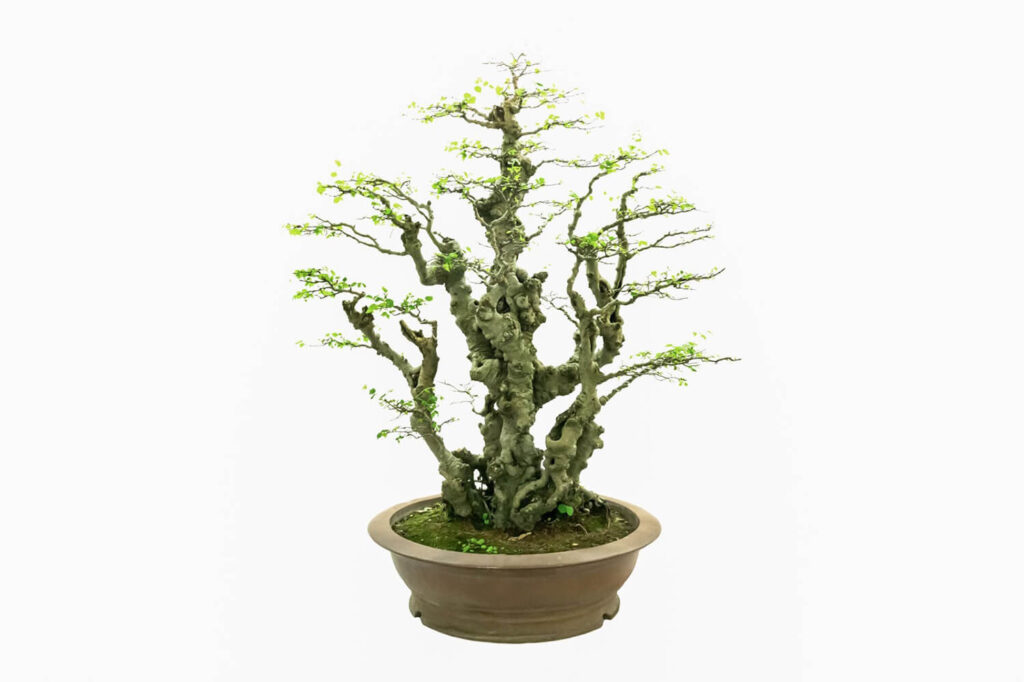
Inspiration: Trees in the wild that naturally have multiple trunks.
This style has three or more trunks growing out of a single root system, which altogether helps form one crown. The most well-developed trunk is at the center of the pot, surrounded by thinner or smaller trunks.
Here are the more specific names of specimens based on the number of their trunks:
- Sakan: 3-trunk bonsai
- Gokan: 5-trunk bonsai
- Nanakan: 7-trunk bonsai
- Kyukan: 9-trunk bonsai
12. Ikadabuki (Raft)
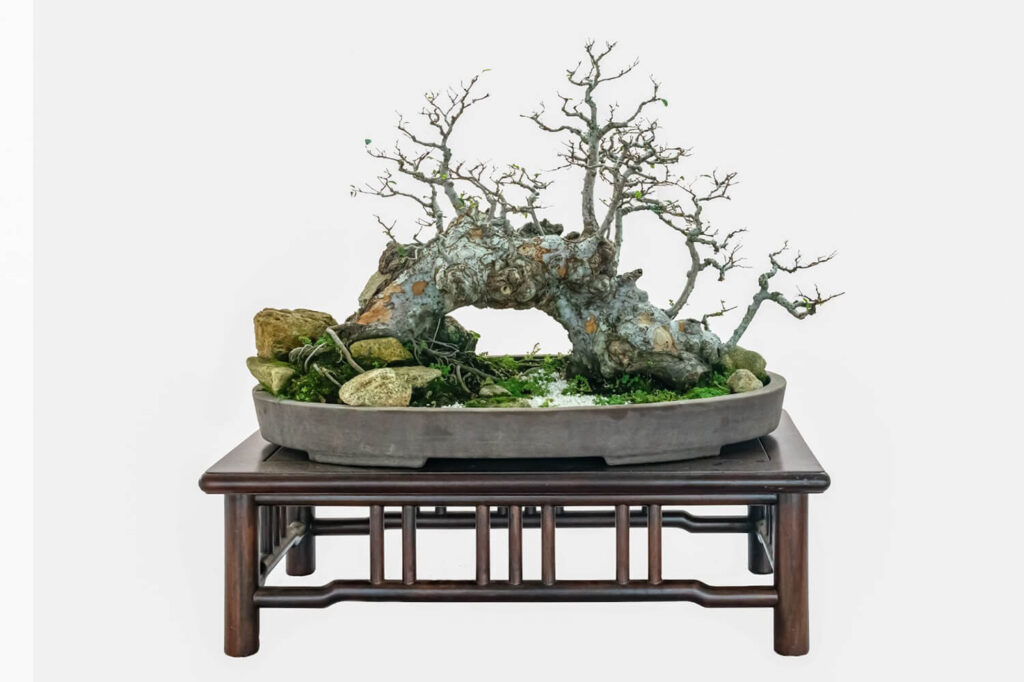
Inspiration: Cracked trees in the wild that survived by branching upward.
It’s similar to kabudachi, except that the trunks grow out of a larger horizontal trunk. Artists create this by grafting plants into a trunk.
Likewise, its multiple trunks form one crown to make it look like a single potted tree.
13. Yose-ue (Forest)
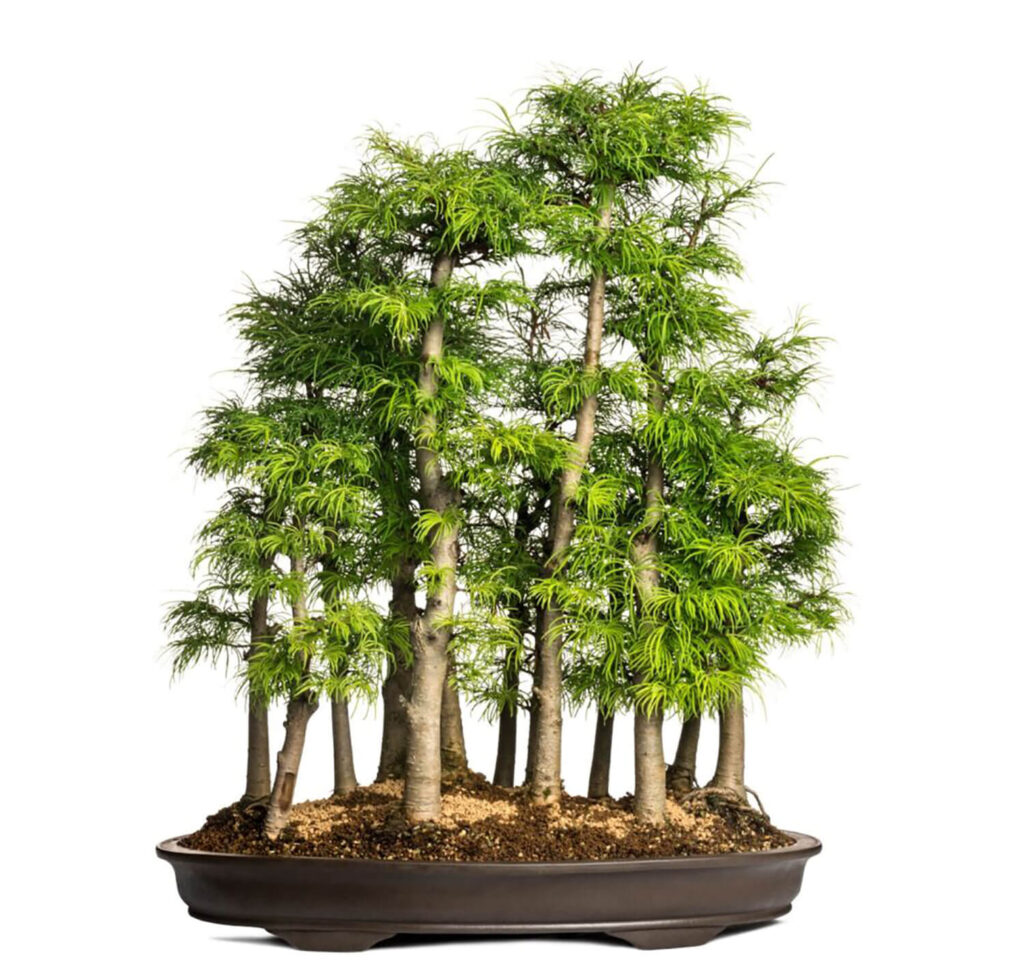
Inspiration: Cluster of mature trees in the mountains or the wild.
Non-enthusiasts may mistake it for a kabudachi since it also has multiple trunks. However, this style consists of several different trees with individual root systems, planted in a single container to make a realistic miniature forest.
14. Seki-joju (Root-over-rock)
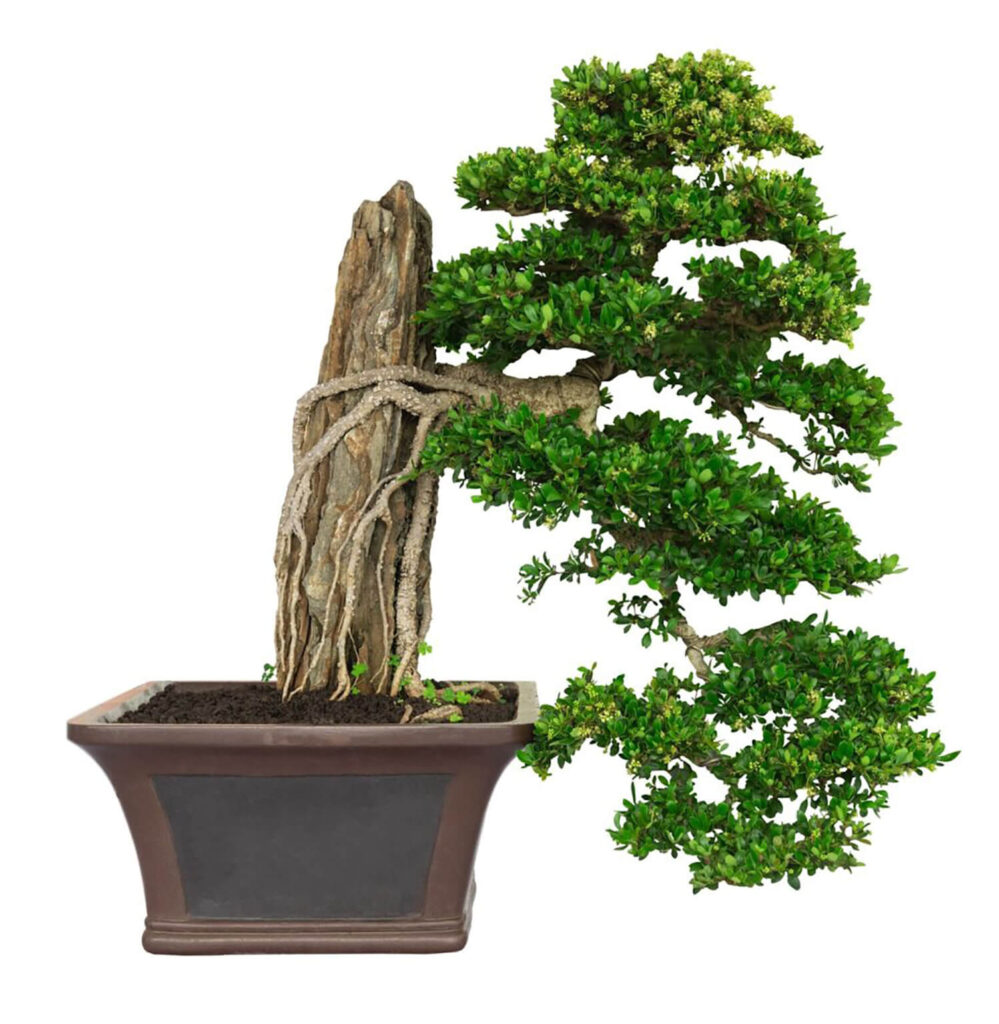
Inspiration: Trees in rocky terrains searching for nutrient-rich soil between the rock’s cracks and holes.
Creating this style is challenging as it requires the grower to master some important techniques. Otherwise, the plant would die from the lack of proper protection, care, and nutrients.
15. Ishizuki (Growing-in-rock)
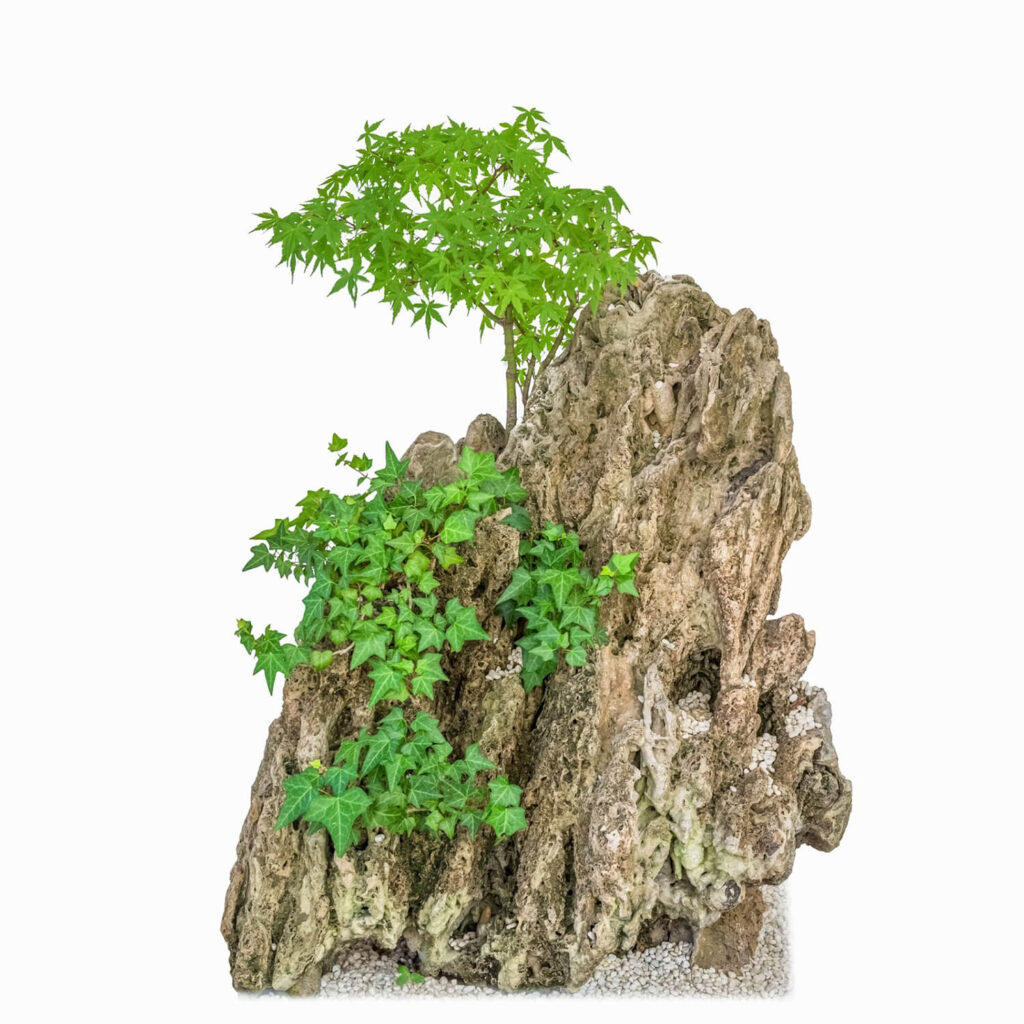
Inspiration: Trees in nature that are growing in between the rocks’ cracks and holes.
Unlike seki-joju, this style has its plants growing directed on the cracks and holes of the rock.
Since these areas have little to no nutrients for the roots to absorb, it’s “normal” for planted specimens to look underdeveloped. Hence, watering and fertilizing are highly important for such trees.
Most popular bonsai tree species
Although many tree species can be turned into bonsai, some specific species are preferred due to their growth habit and characteristics.
Here are just some of the popular tree species that many enthusiasts like:
- For flowering trees: Cherry and plum
- For pines: Shohaku (matsu and shimpaku)
- For fruit-bearing trees: Persimmon and quince
- For maples: Those that change leaves colors in the fall (e.g. Japanese Maple)
Note: Just because these tree species are popular among the community, that doesn’t mean that you should just limit your choices on these options.
To ensure that your tree will thrive, choose a tree native to your area. Native trees in their native habitat are significantly easier to maintain and safe to grow outdoors year-round.
You can grow tropical species in temperate areas as long as you provide them with proper winter protection.
Conclusion
Bonsai growing is both an art and horticultural practice enjoyed by many enthusiasts within and outside Japan for hundreds of years.
Although it originated from the ancient Chinese horticultural practice called penjing, the Japanese have popularized it globally, making Japan the center of bonsai art.
Unlike what the public may think, these trees aren’t genetically dwarf plants. They’re just regular tree specimens trained in small, shallow containers to control their growth. You can turn any tree or shrub species into a bonsai as long as they have the needed qualities.
More importantly…
Anyone with enough knowledge, dedication, and patience can grow a healthy and thriving miniature tree!
Read next: Are Bonsai Trees Expensive to Grow?





0 Comments